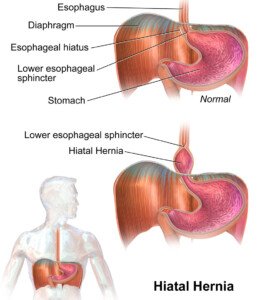Did you have a Nissen fundoplication for hiatal hernia and are confused about weightlifting guidelines?
Strength training, bodybuilding & powerlifting require clear, concise guidelines that should not leave the patient wondering, guessing or interpreting the wrong way.
Here are clear guidelines for bodybuilding, powerlifting and strength training.
Perhaps your surgeon has given you very general guidelines, maybe something to the tune of, “Don’t lift heavy weights,” or, “Don’t do any straining when you work out.”
To someone who has always been passionate about building muscle or competing in powerlifting events, hearing these restrictions is a pummeling blow.
It’s bad enough to implement these restrictions for several weeks out from the surgery.
But what about for the rest of your life?
Nissen Fundoplication for Hiatal Hernia: Short-Term Weightlifting Guidelines

BruceBlaus/CC
“A general rule of thumb would be to avoid all heavy weightlifting for six weeks post-op to allow the fundoplication to heal,” says Santosh Sanagapalli, MD, a consultant gastroenterologist, endoscopist and specialist in esophageal disorders.
“Any form of lifting heavy weight increases intra-abdominal pressure, and this can place pressure on the fundoplication, causing the fundoplication to loosen or come undone,” explains Dr. Sanagapalli.
“In this immediate post-operative period the patient should stick to aerobic exercise such as walking, cycling or swimming.”
The absence of “heavy weightlifting” doesn’t mean avoid all forms of resistance exercise for those who are serious about strength training.
You can work out with tension bands without inducing intra-abdominal pressure.
Ask your surgeon specifically about tension bands rather than asking the too-general, “Can I lift light weights?”
If approved, you should play safe by NOT doing an 8-12 RM for any of the exercises.
Instead, use a tension band color, and/or set it up, such that you can perform 20 repetitions.
For an extra layer of precaution, make sure the set does not exceed 80% of your maximal effort for those 20 reps.
This will keep your muscles active during those six weeks.
Pictured below are examples of resistance band exercises.

Row. Shutterstock/Aaron Amat

Chest press. Shutterstock/InnerVisionPRO

Lateral raise. Shutterstock/Oleksandr Zamuruiev

Arm curl. Shutterstock/aijiro
Long-Term Strength Training Guidelines for Hiatal Hernia Nissen Fundoplication
“Long-term, the guidance is trickier,” says Dr. Sanagapalli.
“In theory, it would make sense that any form of heavy straining such as weightlifting would put strain on the fundoplication and predispose it to coming undone.
“Indeed, there is evidence that shows weightlifting is a risk factor for disruption and failure of the fundoplication.
“It may not happen in everybody, but it is likely that it increases risk.
“Therefore, the advice is partially dependent on the wishes of the patient.
“If the patient is not wedded to the idea of doing weightlifting, then it would be preferable and rational that they undertake other forms of exercise that do not unduly increase intra-abdominal pressure (due to excessive straining), e.g., cycling, running and swimming, as mentioned above.
“Lighter weights can be lifted with more ‘reps’ so as to avoid excessive straining with large weights.”
So after six weeks, you can feel a little more at ease using standard gym equipment.

Freepik.com
If you’ve been lifting weights purely for physical fitness, then it won’t be too troubling for you to avoid any resistance that induces a feeling of straining.
You can still bench press, deadlift, squat, leg press and do bent-over dumbbell rows, dumbbell chest presses, biceps curls, etc., along with machines – with the caveat that the weight load must NOT require any straining.
A safeguard against this is to adhere to a minimum of 15 reps for most exercises, and perhaps 18-20 for big compound moves (barbell squat, deadlift, tire flip).
This will work just fine if your only goal is fitness, muscle toning, stronger joints and just overall good musculoskeletal health.
What about those who can’t bear to give up heavy weightlifting?

Shutterstock/YanLev
“On the other hand, if the patient was a professional weightlifter or bodybuilder, I would not prohibit weightlifting since it is an important part of their life,” says Dr. Sanagapalli.
This guideline means resume your pre-Nissen workouts (taking it easy at first to avoid joint injury, and gradually working your way up to pre-op resistance).
However, Dr. Sanagapalli adds, “But they would need to accept that they faced a higher risk of needing redo fundoplication in the future.”
What exactly happens if lifting weights disrupts the fundoplication?
“In the immediate post-operative period (until the skin incision site heals fully), there is a risk of surgical wound dehiscence (re-opening) from lifting heavy weights which could cause pain around the surgical wound site, visible reopening, bleeding externally and rarely an emergency situation,” says Dr. Sanagapalli.
“There is no significant risk of internal bleeding.
“Later on, a disrupted fundoplication refers to gradual loosening of the wrap and symptom recurrence over time (i.e., months to years).
“This never represents an emergency situation.”
Additional Guidelines
To minimize straining, make sure your form is textbook perfect, especially for the deadlift and squat.
Never hold your breath during any point of the lift.
Exhale as you perform the lift, and take a deep inhalation as you release or lower the weight (the “negative” segment of the exercise).
What about the amount of weight lifted?
These guidelines do not identify any numbers because what’s “heavy” to one person is another’s warmup.
What makes one person strain and grunt would require only moderate effort in another individual.
 Dr. Sanagapalli is a gastroenterologist and director of the Esophageal Disorders Center at St Vincent’s Hospital, Darlinghurst. He performs diagnostic and therapeutic endoscopic procedures, and enjoys providing comprehensive and holistic care to patients with a wide variety of disorders affecting the gastrointestinal tract.
Dr. Sanagapalli is a gastroenterologist and director of the Esophageal Disorders Center at St Vincent’s Hospital, Darlinghurst. He performs diagnostic and therapeutic endoscopic procedures, and enjoys providing comprehensive and holistic care to patients with a wide variety of disorders affecting the gastrointestinal tract.
 Lorra Garrick has been covering medical, fitness and cybersecurity topics for many years, having written thousands of articles for print magazines and websites, including as a ghostwriter. She’s also a former ACE-certified personal trainer.
Lorra Garrick has been covering medical, fitness and cybersecurity topics for many years, having written thousands of articles for print magazines and websites, including as a ghostwriter. She’s also a former ACE-certified personal trainer.



























